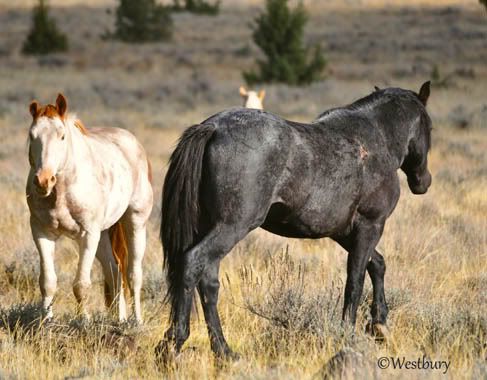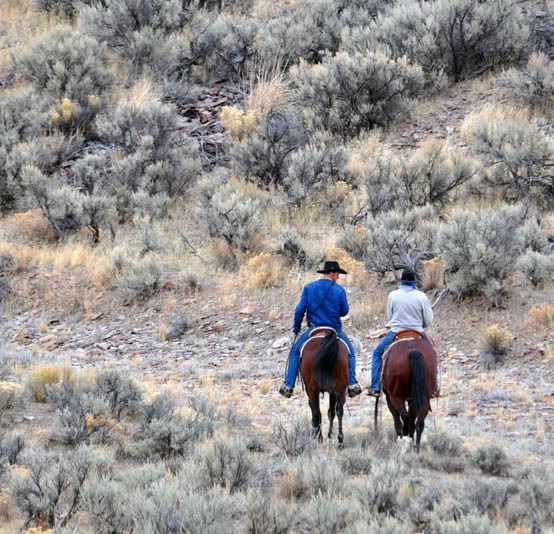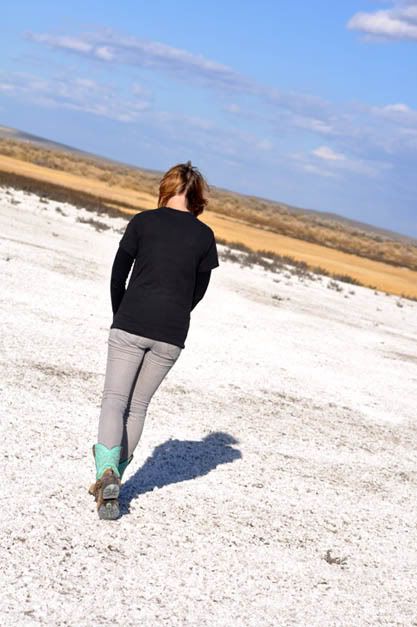Up on the South Steens, horses are plump and happy. Yet over at Warm Springs they're barely getting by. Heading into winter, we want our horses to have a heavy enough later of fat on them to protect them from the bitter cold of winter. If you live in a cold region where the winds howl, you know what it's like to feel the frigid air, and frostbite is a real concern.


The old stallion, often referred to as One Ear Jack, knows what it's like to live in a harsh winter climate. Frostbite had caused the loss of half an ear. This is not uncommon among wild horses. Last year a mare was gathered that had just two little nubs the size of bunny tails where her ears should have been.
The terrain plays a big role in what a wild horse looks like going into winter. On the South Steens, grass is abundant, even as late as our trip in early November. A late fall warm streak helped a surge of new grass to burst forth in addition to the longer, yellow grasses of late summer. While the yellow grass lacks nutrition, it still is a good source of forage. And the South Steens horses were gathered just a year ago, dropping their number down to roughly 150 horses, less than a third of what had been here a year earlier.

South Steens

South Steens
Meanwhile, down the mountain near Foster Flat, the horses at Warm Springs are struggling. Some carry enough flesh to be considered in good condition by our domestic horse standards. But take into consideration that our domestics will likely have feed in front of them all winter, are provided with shelter and often blankets to help them stay warm, and you (should) begin to see that being 'perfect' in weight may be an issue a couple months into winter.
On Warm Springs the grass is yellow, but not tall. There isn't the green that you see on the South Steens. The sage brush is over six feet high and plentiful in some areas. The horses haven't been gathered in four years and their population on this barren land is currently over 500.

On Warm Springs the grass is yellow, but not tall. There isn't the green that you see on the South Steens. The sage brush is over six feet high and plentiful in some areas. The horses haven't been gathered in four years and their population on this barren land is currently over 500.

Further on down the road, across the valley and near the Palomino Butte HMA, horses as well as other livestock and wildlife find themselves munching their way around deposits of soda ash, a result of soil heavy in alkali.


It is important for us to realize just what these horses go through on a daily basis...to see the big picture, if you will...when we try to make decisions concerning whether or not it's humane to gather. When horses start coming in looking like those we've seen from Warm Springs (posted yesterday), we need to weigh the options. Leaving them alone would create an even greater number of horses...can the land truly sustain them? Even if we took off all the cattle...how long would it last?


6 comments:
Such a controversy... Such heart ache...
I understand why the gathers are necessary...
It's not that I don't agree with the gathers, it's that I don't agree with how the gathers are performed? But I don't know a better way...
But then again I live in the East side of the country and all I know about gathers is what the media tells me. I take it all with a grain of salt obviously.
Honesty from the BLM and Gov't agencies and education to the public is what is needed. You are trying to educate us and I am grateful.
Jen, from what I saw in the video from Saturday's gather, the helicopter did an excellent job. He stayed back and didn't come in close at all until he really needed to pressure the horses to move into the catch pen.
I find it amazing that the horses really haven't got any post gather trauma over any of it. My horses could care less about planes or helicopters that fly over, and the helicopters get rather low sometimes. No reaction at all.
It would be nice if there were a way to make it happen without the catch pen stress (which is where the accidents tend to happen, should a horse panic and bolt), but I'm not entirely sure what that is, either. We talked about making the panels that lead into the pen solid, so the horses don't think they can duck through. Flip side to that is, the horses see a solid wall and won't go in. Guess they tried it...sigh...
My husband and I went to Burns last weekend for the gather that took place on Saturday. Having Friday free we visited the corrals. After seeing the Warm Springs horses already gathered and noticing a lot of the mare/foal pairs were so thin we wondered how they would make it through the Winter if left on the range. I knew then the gather was justified, no doubts.
The helicopter pilot did stay way behind the herd and even backed off if the herd began to gallop at full speed. Most of the time it was at a trot. When the horses would get closer to the catch site the helicopter would sweep down behind the horses to hold them at bay while the wranglers closed the gate. We witnessed the bay roan mare bolting and hitting the panel, what a tragedy that was. We were all devastated but at the same time remembered the shape of the horses at the corrals which would be more likely to leave a lot of horses, including foals ...dead on the range. We feel the catch (trap) site needs some tweaking and we're trying to think of a design that would be more safe and before the next gather maybe we can implement ideas! This is why we feel the people need to work together and not fight our land management but instead somehow find a way to work together!
Thank you for sharing such an open and honest account of the situation. It's easy to be judgmental when you're not there; thank you for shedding the light and educating us!
~Amber
great post.
Lovely pictures.
And sigh, I loved that little frostbite mare!
(my verification word is pigness...)
Love the blog. Love your down to earth view on the mustangs and the fact that you ACTUALLY KNOW WHAT YOU'RE TALKING ABOUT *gasp* I'll be reading :)
Post a Comment